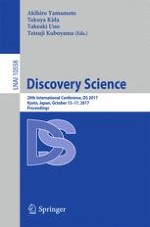This book constitutes the proceedings of the 20th International Conference on Discovery Science, DS 2017, held in Kyoto, Japan, in October 2017, co-located with the International Conference on Algorithmic Learning Theory, ALT 2017.
The 18 revised full papers presented together with 6 short papers and 2 invited talks in this volume were carefully reviewed and selected from 42 submissions. The scope of the conference includes the development and analysis of methods for discovering scientific knowledge, coming from machine learning, data mining, intelligent data analysis, big data analysis as well as their application in various scientific domains. The papers are organized in topical sections on machine learning: online learning, regression, label classification, deep learning, feature selection, recommendation system; and knowledge discovery: recommendation system, community detection, pattern mining, misc.
